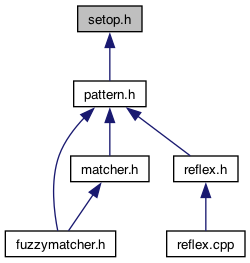RE/flex operations on STL containers and sets. More...

Classes | |
| struct | reflex::lazy_intersection< S1, S2 > |
| Intersection of two ordered sets, with an iterator to get elements lazely. More... | |
| struct | reflex::lazy_intersection< S1, S2 >::iterator |
| Iterator to lazely get elements of a set intersection. More... | |
| struct | reflex::lazy_union< S1, S2 > |
| Union of two ordered sets, with an iterator to get elements lazely. More... | |
| struct | reflex::lazy_union< S1, S2 >::iterator |
| Iterator to lazely get elements of a set union. More... | |
Namespaces | |
| reflex | |
Functions | |
| template<typename S1 , typename S2 > | |
| bool | reflex::is_disjoint (const S1 &s1, const S2 &s2) |
Check if sets s1 and s2 are disjoint. More... | |
| template<typename T , typename S > | |
| bool | reflex::is_in_set (const T &x, const S &s) |
Check if value x is in set s. More... | |
| template<typename S1 , typename S2 > | |
| bool | reflex::is_subset (const S1 &s1, const S2 &s2) |
Check if set s1 is a subset of set s2. More... | |
| template<typename S1 , typename S2 > | |
| void | reflex::set_insert (S1 &s1, const S2 &s2) |
Insert set s2 into set s1. More... | |
| template<typename S , typename E > | |
| void | reflex::set_add (S &s, const E &e) |
Insert element e into set s. More... | |
| template<typename S1 , typename S2 > | |
| void | reflex::set_delete (S1 &s1, const S2 &s2) |
Delete elements of set s2 from set s1. More... | |
| template<typename S , typename E > | |
| void | reflex::set_erase (S &s, const E &e) |
Remove element e from set s when present. More... | |
RE/flex operations on STL containers and sets.
reflex::is_disjoint<S1,S2>(S1 s1, S2 s2) is true if s1 and s2 are disjoint sets.
reflex::is_subset<S1,S2>(S1 s1, S2 s2) is true if s1 is a subset of s2.
reflex::is_in_set<T,S>(T x, S s) is true if x is in s.
reflex::set_insert<S1,S2>(S1 s1, S2 s2) inserts elements of s2 into s1.
reflex::set_delete<S1,S2>(S1 s1, S2 s2) deletes elements of s2 from s1.
reflex::lazy_intersection<S1,S2>(S1 s1, S2 s2) is a structure with an iterator over elements that are in s1 and in s2.
reflex::lazy_union<S1,S2>(S1 s1, S2 s2) is a structure with an iterator over elements that are in s1 or in s2.
The rationale for using reflex::lazy_intersection and reflex::lazy_union is to save memory when the results do not need to be stored in a set, since the elements are lazely produced by an iterator.